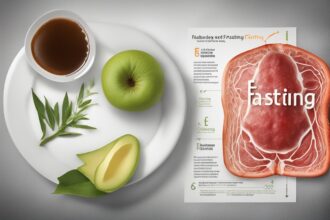Fasting, a practice rooted in both cultural traditions and modern health trends, has gained significant attention for its potential benefits in promoting cellular health and combating oxidative stress. One of the most compelling aspects of fasting is its ability to reduce cellular damage, a process intricately linked to aging and chronic diseases. By exploring the concept of reducing cellular damage through fasting, we can uncover how this age-old practice might hold the key to enhancing longevity and overall well-being. In this article, we’ll dive into the science behind fasting, its impact on oxidative stress, and how it can protect our cells from harm.
The Link Between Fasting and Cellular Damage
Cellular damage occurs when harmful molecules, such as free radicals, accumulate in the body and disrupt the normal functioning of cells. This damage is often a result of oxidative stress, a condition where the body’s antioxidant defenses are overwhelmed by reactive oxygen species (ROS). Fasting, particularly intermittent fasting or prolonged fasting, has been shown to mitigate this damage by triggering protective mechanisms at the cellular level. By reducing the intake of calories temporarily, fasting allows the body to shift its focus from growth and reproduction to repair and maintenance, a state that directly contributes to reducing cellular damage through fasting.
During fasting, the body enters a state of metabolic switching, where it begins to utilize stored energy sources like fat. This process not only reduces the production of ROS but also enhances the body’s ability to neutralize them through antioxidant pathways. As a result, fasting acts as a natural detox for cells, clearing out damaged components and promoting resilience against oxidative stress.
How Fasting Reduces Oxidative Stress
Oxidative stress is a major contributor to cellular damage, aging, and the development of diseases such as cancer, diabetes, and neurodegenerative disorders. Fasting plays a crucial role in combating oxidative stress by upregulating the body’s endogenous antioxidant systems. For instance, fasting has been shown to increase the production of enzymes like superoxide dismutase (SOD) and glutathione peroxidase, which neutralize free radicals and prevent cellular damage.
Additionally, fasting induces a state of mild stress on the body, known as hormesis. This controlled stress prompts cells to activate protective mechanisms, such as the Nrf2 pathway, which regulates antioxidant responses. By embracing reducing cellular damage through fasting, individuals can harness these natural defenses to lower oxidative stress and protect their cells from long-term harm. To learn more about the broader benefits of fasting, check out our post on Fasting for Longevity: Key Benefits.
Autophagy: The Cellular Cleanup Process Triggered by Fasting
One of the most powerful mechanisms through which fasting reduces cellular damage is autophagy, a process often described as the body’s “cellular cleanup.” Autophagy involves the degradation and recycling of damaged or dysfunctional cellular components, such as misfolded proteins and impaired mitochondria, which are major sources of ROS. By removing these harmful elements, autophagy plays a pivotal role in reducing cellular damage through fasting.
During fasting, the lack of nutrients signals the body to prioritize survival over growth, leading to the activation of autophagy. Studies have shown that this process not only clears out cellular debris but also improves mitochondrial efficiency, further reducing oxidative stress. For a deeper dive into how autophagy works, explore our article on Autophagy and Fasting: A Cellular Renewal Guide.
Fasting and Inflammation: A Dual Approach to Cellular Protection
Inflammation is another key factor that exacerbates cellular damage, often working hand-in-hand with oxidative stress to accelerate aging and disease progression. Chronic inflammation creates an environment where free radicals thrive, leading to further cellular harm. Fasting has been shown to reduce systemic inflammation by lowering levels of pro-inflammatory cytokines and promoting anti-inflammatory pathways.
By curbing inflammation, fasting indirectly supports reducing cellular damage through fasting. For instance, intermittent fasting regimens, such as the 16:8 method (16 hours of fasting followed by an 8-hour eating window), have been linked to decreased markers of inflammation like C-reactive protein (CRP). This dual action—reducing both inflammation and oxidative stress—makes fasting a powerful tool for cellular protection. If you’re interested in fasting schedules, read our guide on Intermittent Fasting Schedules for Beginners.
Practical Tips for Fasting to Reduce Cellular Damage
While the science behind reducing cellular damage through fasting is promising, it’s important to approach fasting with a well-informed strategy to maximize its benefits and minimize risks. Here are some practical tips to get started:
- Start Slow: If you’re new to fasting, begin with shorter fasts, such as a 12-hour overnight fast, before progressing to longer durations like 16:8 or 24-hour fasts.
- Stay Hydrated: Drink plenty of water during fasting periods to support detoxification and prevent dehydration, which can exacerbate oxidative stress.
- Focus on Nutrient-Dense Foods: When breaking your fast, prioritize antioxidant-rich foods like berries, leafy greens, and nuts to further combat cellular damage.
- Listen to Your Body: Fasting isn’t suitable for everyone. Pay attention to how your body responds and consult a healthcare professional if you experience adverse effects.
For additional guidance on incorporating fasting into your routine, check out our post on Fasting Safely: Tips for Beginners.
Potential Risks and Considerations
While fasting offers significant potential for reducing cellular damage through fasting, it’s not without its challenges. Extended fasting periods can lead to nutrient deficiencies, muscle loss, or fatigue if not done properly. Certain populations, such as pregnant women, individuals with eating disorders, or those with chronic medical conditions, should avoid fasting or seek medical advice before starting.
Moreover, overdoing fasting or combining it with extreme calorie restriction can sometimes increase oxidative stress rather than reduce it, as the body may enter a state of excessive stress. Balance is key, and fasting should be tailored to individual needs and lifestyles. For more insights into who should avoid fasting, refer to our article on Fasting Risks: Who Should Avoid It?.
Disclaimer: The information provided in this article is for educational purposes only and should not be considered medical advice. Fasting may not be suitable for everyone, and individual results may vary. Before starting any fasting regimen, especially if you have pre-existing health conditions or are on medication, consult with a qualified healthcare professional to ensure it is safe for you. The authors and publishers of this content are not responsible for any adverse effects or consequences resulting from the use of the information provided.
References
- Mattson, M. P., & Wan, R. (2005). Beneficial effects of intermittent fasting and caloric restriction on the cardiovascular and cerebrovascular systems. Journal of Nutritional Biochemistry.
- de Cabo, R., & Mattson, M. P. (2019). Effects of Intermittent Fasting on Health, Aging, and Disease. New England Journal of Medicine.
- Mihaylova, M. M., & Shaw, R. J. (2011). The AMPK signalling pathway coordinates cell growth, autophagy and metabolism. Nature Cell Biology.
- Longo, V. D., & Mattson, M. P. (2014). Fasting: Molecular Mechanisms and Clinical Applications. Cell Metabolism.
- Anton, S. D., et al. (2018). Flipping the Metabolic Switch: Understanding and Applying the Health Benefits of Fasting. Obesity.
This content is for informational purposes only and not a substitute for professional advice.






